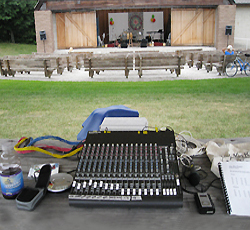
Ask the band to play a song all together as you set up a house mix. Then ask them to play a short section of a few different song styles.
Touch Up The Monitor Mixes
You, or the monitor mixer, will set each performer’s monitor mix so they can hear themselves and any other parts they need to hear. That’s not necessarily the same as the house mix.
Ask each player what they want in their monitor. If the monitors seem “hot” overall and are starting to ring, turn down the master monitor send a little.
Some musicians comment on the monitor tonal balance. They may want less bass, less mids, more highs, or whatever.
If your monitor sends do not have EQ, you can tweak the graphic EQ that is feeding the monitor power amp.
Note that the musicians are hearing the bass-y sound off the back of the house loudspeakers, so they may not need much bass in the monitors.
That’s great – then you can roll off or filter out the lows in the monitors, which also reduces rumble and feedback.
Controlling Stage Volume
If you turn up a vocalist’s mic in the monitors, and the instruments are very loud at that mic, you also turn up those instruments in the monitors.
You need to get more vocals and less instruments at the singer’s mic. So ask the vocalist to sing with lips touching the mic’s foam pop filter, and don’t place the vocal mic right in front of a guitar amp or drum kit. Turn down the instruments if possible.
If the guitar amps’ stage volume is too high, suggest that the guitar players place their amps to their side, aiming up at their ears so the amps will sound louder to them.
Then you can turn down the amps. Other tools for reducing stage volume are in-ear monitors, clear plastic drum baffles, and electronic drums.
Muting
Make sure that musicians with DI’s alert you when they want to unplug or plug in. Mute their channel when they signal in order to avoid loud pops in the sound system.
Caution: some mixing consoles do not mute the monitors when the channel is muted. In that case, temporarily turn down the monitor send for that channel, then reset it where it was.
Warm-Up Acts
If there’s a warm-up band (support act), put them on different faders or a different mixer than the main act if possible.
Note which channels the monitor mix cables are plugged into. If you shift the monitor mix cables from one mixer to the other, you’ll need to put them back where they were.
After sound checking the headline act, do the same for the support act. The concert starts with the support act, and when they finish, it’s time for changeover.
